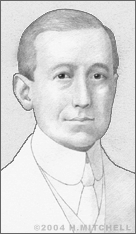Guglielmo Marconi
Radio pioneer Guglielmo Marconi was born in Bologna, Italy, on April 25, 1874, to an Italian father and Irish mother. Educated in physics at the technical school in Leghorn, Marconi had, by the age of 20, become very interested in the works of Heinrich Herz, who had discovered and first produced radio waves in 1888. Marconi was convinced that communication among people was possible via wireless radio signaling. In 1895, he began to experiment at his father’s home in Pontecchio, where he was soon able to send signals over one and a half miles.
Marconi traveled to England in 1896 to seek a patent for his apparatus. One was granted to him that year – the first patent ever granted for a system of wireless telegraphy. After demonstrating the system’s ability to transmit radio signals across the Bristol Channel, he established the Wireless Telegraph and Signal Company Limited (re-named Marconi's Wireless Telegraph Company Limited in 1900).
In 1899, Marconi was able to transmit signals across the English Channel, from Britain to France. A year later, he received a patent for "tuned or syntonic telegraphy.” This patent number 7,777 allowed simultaneous transmissions on different frequencies. Thus, stations next to one another were able to operate without interfering with the others’ signals. Adjacent stations were now able to operate without interfering with one another, and ranges were increased.
Marconi’s most significant breakthrough was yet to come. In December of 1901, he proved the skeptics wrong when he successfully transmitted wireless waves across the Atlantic Ocean, between Poldhu, Cornwall and St. John’s, Newfoundland. This distance of 2100 miles disproved the widely held theory that the curvature of the earth would prevent the waves from reaching their destination.
In 1902, Marconi patented a magnetic detector, which became the standard wireless receiver for years to come. In 1905, he patented the horizontal directional aerial. During these early years, Marconi’s invention proved itself a lifesaving technology to a particular group of people: those at sea. Marconi had hoped from the beginning that the system would end their isolation and give them a way to call for help. The first incident that demonstrated this potential came in 1899 when a vessel rammed by a steamship in heavy fog used the system to call for a lifeboat. In 1909, when the S.S. Republic collided with an Italian steamer, the Marconi radio operator onboard the Republic was able to guide rescue ships to its position to save more than 1,700 passengers. When the Titanic sank in 1912, calls for help came through the Marconi equipment onboard so that some passengers’ lives were spared.
In 1909, Marconi won the Nobel Prize in physics, which was shared with Karl Ferdinand Braun, who had modified Marconi’s transmitters to increase their range and practicality. Marconi was decorated with numerous other awards and honors throughout his lifetime. In 1914, he became a Lieutenant in the Italian Army. He was later promoted to Captain and, in 1916, became a Commander in the Navy. In 1919, he received the Italian Military Medal for his war service. His systems had gradually made their way into the workings of the military. Meanwhile he continued to experiment, opening the world’s first microwave radiotelephone link in 1932. Later, he introduced the microwave beacon for ship navigation.
In the 1920s, Marconi’s company was very involved in advancing television transmission in England. In 1934, its television interests were merged with those of EMI Ltd. into a company called The Marconi-EMI Television Co. Ltd. In 1946, Marconi’s Wireless Telegraph Company was taken over by English Electric, and in 1968, English Electric merged with the General Electric Company (GEC). In 1999, GEC was renamed Marconi plc, then Marconi Corporation plc from 2003 to 2006, until it was acquired by Ericsson in 2006.
Marconi moved to Rome in 1935. He died there on July 20, 1937.


